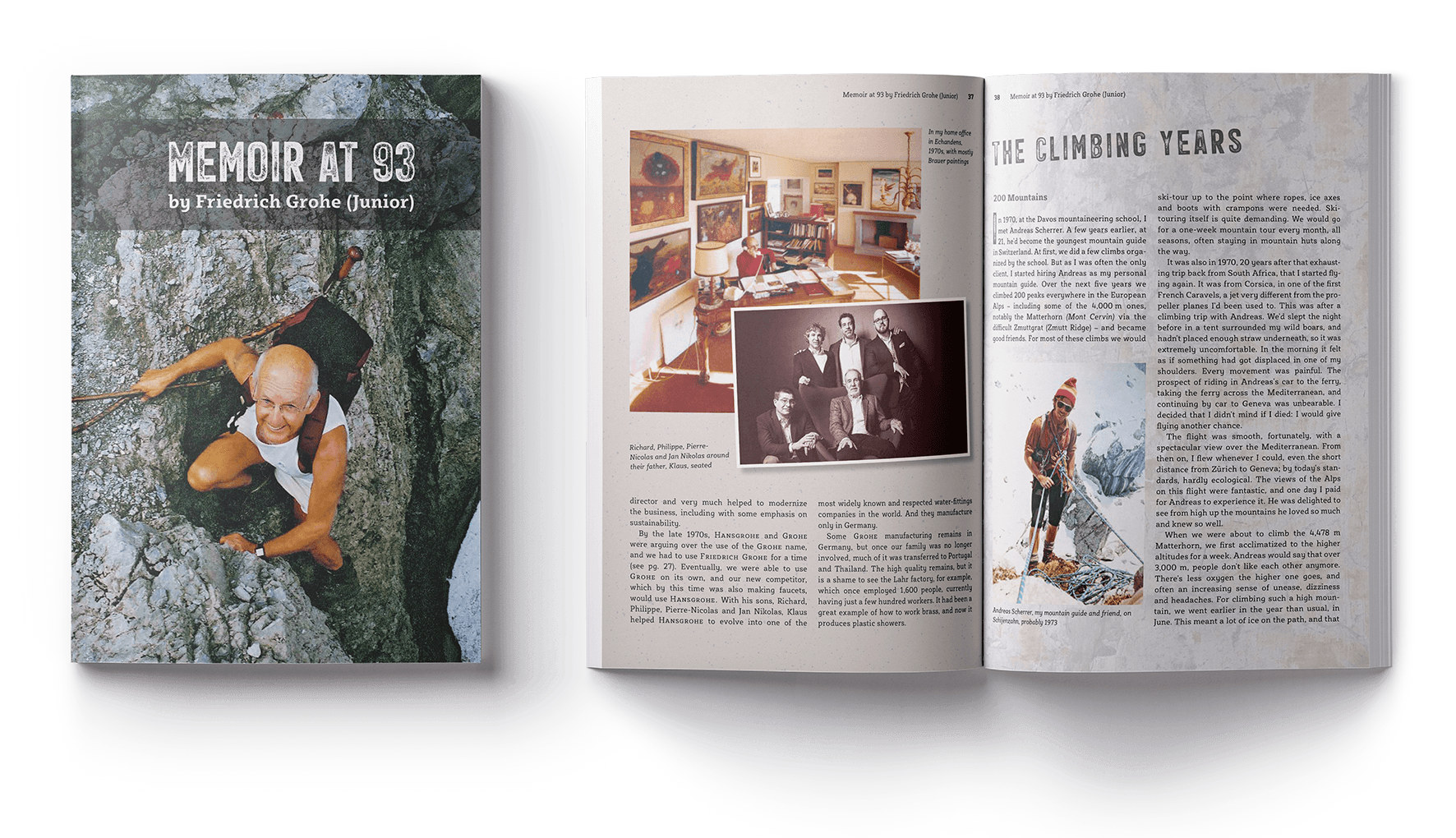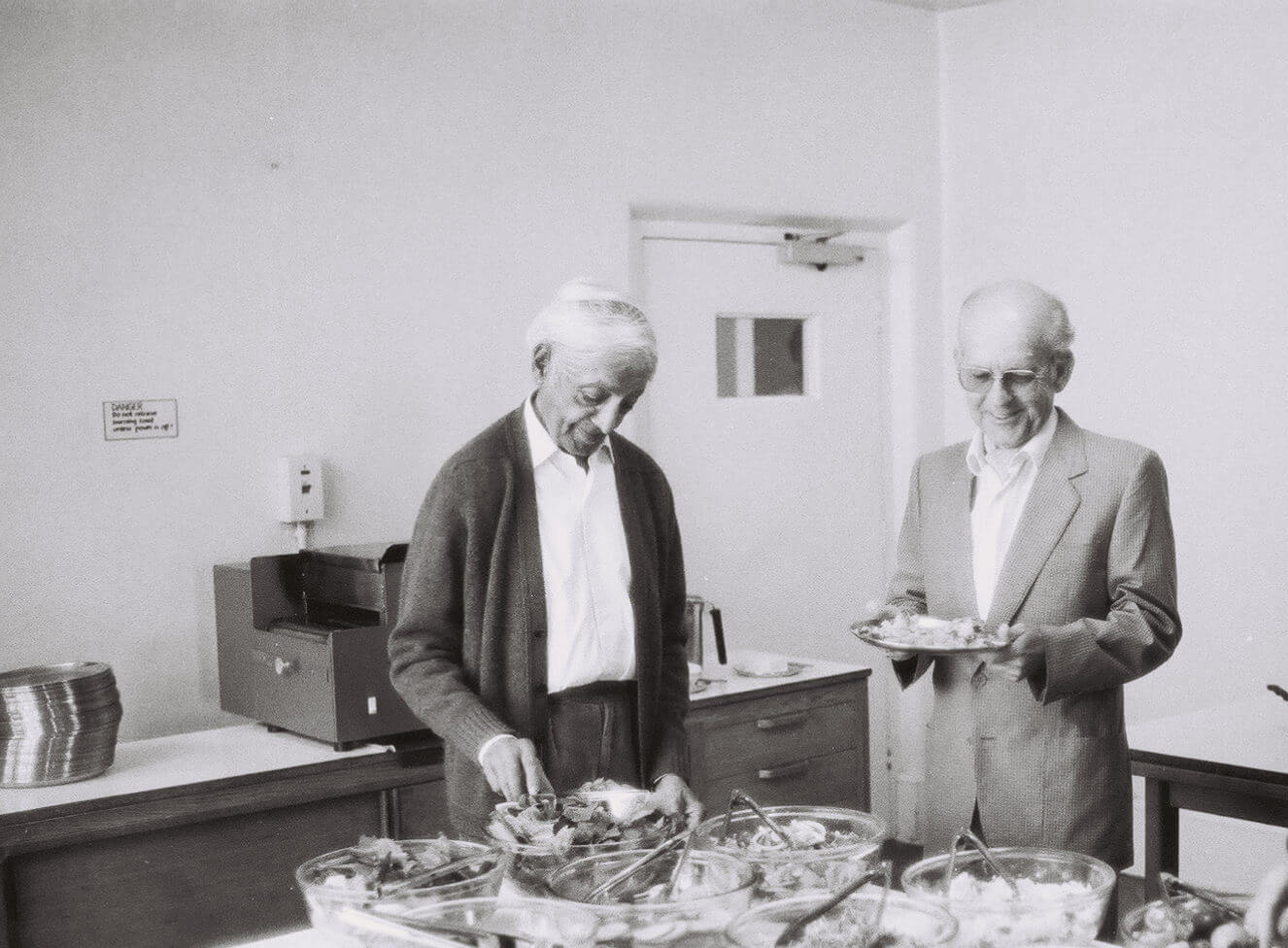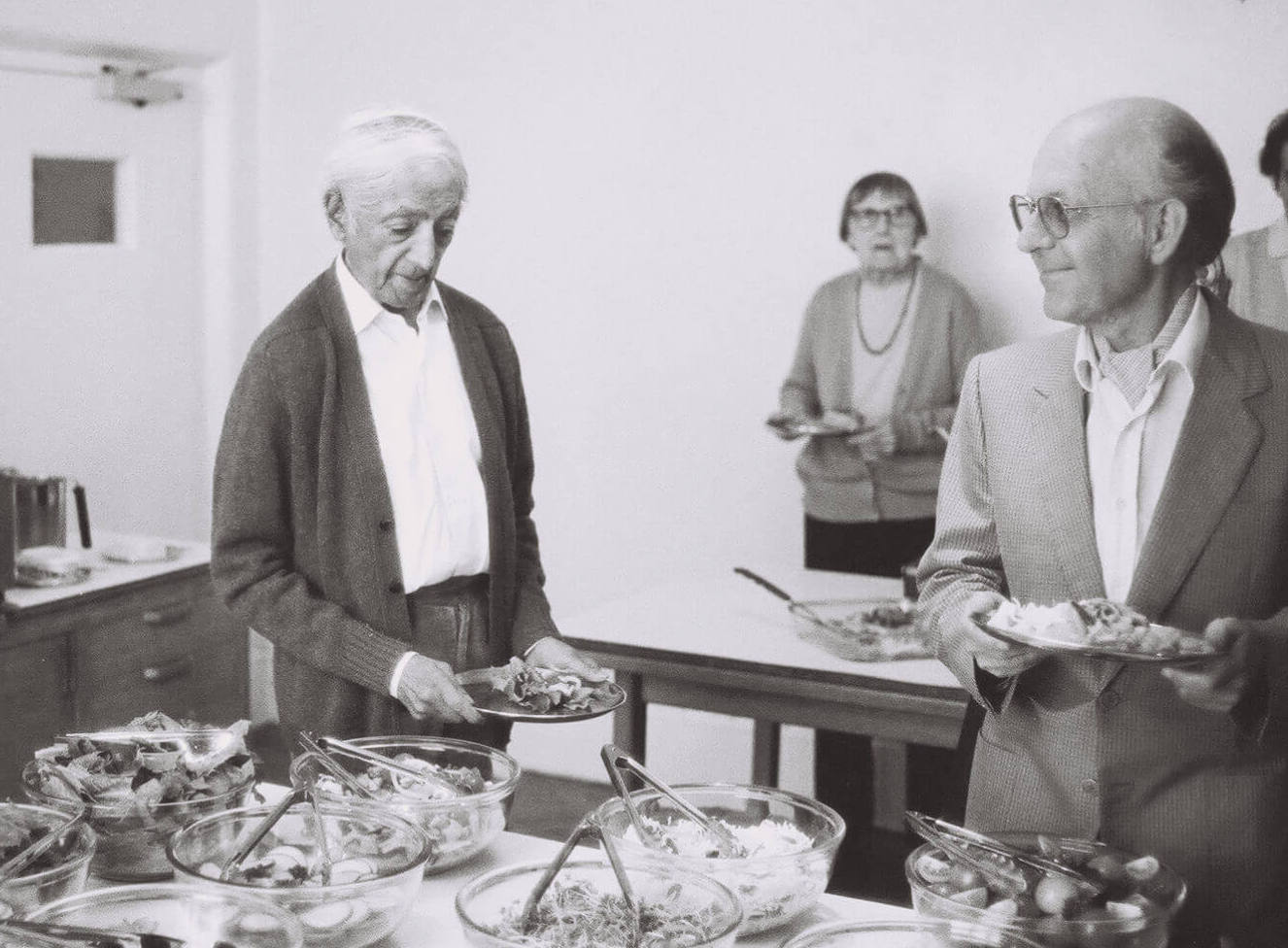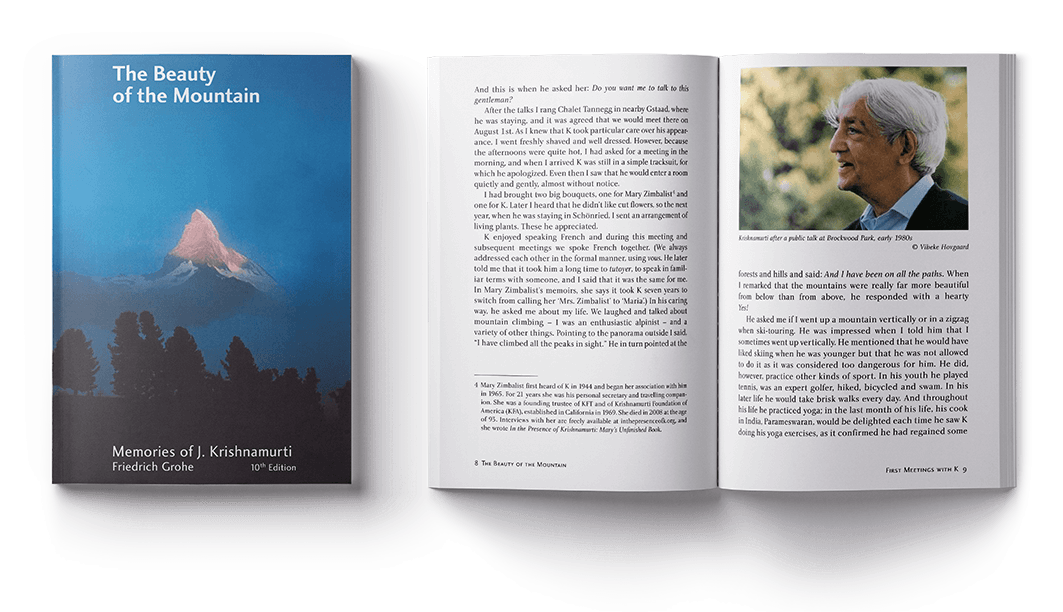“It was overpowering to listen to Krishnamurti. He emanated so much energy that I felt I simply couldn’t sit in front of him. He spoke simply and clearly, with few gestures and no rhetoric.”

SECOND EDITIONNew
Memoir at 93
This memoir offers a concise yet rich account of Friedrich’s early life, and his family, business, and later years.
Autobiography
Hans Arthur Friedrich Grohe was born in the Black Forest town of Schiltach, Germany the 22 nd of September 1929 the first son to Hans Otto Friedrich and Ruth Reymond Grohe. His father was the eponymous founder of the faucet manufacturing company GROHE. Grohe was ten when the Second World War erupted. As a teenager he attended a German boarding school in Davos, Switzerland, but traveled back and forth between the two countries for school holidays. In the final months of the war his time at home was marked by nighttime bombing raids and watching from a distance as cities burned. Seeing the misery in the wake of the war also made a deep impression. After the war food in Germany became scarce and there was little fuel for heat. In 1947 his mother, sister and brother came to visit in Switzerland ; Grohe recalled being shocked by how thin they’d all become. Grohe went to study economics, first at the University of St. Gallen and then the University of Cologne. In 1954 he began work for Grohe Armaturen, his father’s company. He started as a trainee spending five years learning the workings of each department. Grohe Senior had great faith in his son and appointed him, at age 29, to the position of company Head. It was the start of a decade – long tenure during which the company doubled its production and held an unprecedented 45 percent of market share. In 1962, the elder Grohe appointed his son, aged 33, CEO. As the company flourished and expanded, disagreements arose between Grohe and his father. Grohe was ultimately transferred to Vienna to head a newly acquired but struggling factory.
Within three years Grohe had successfully implemented a turnaround plan and the factory was thriving. Not long after, Grohe Senior sold a majority stake in the company and the family members withdrew from management. Relieved to be free of the business world Grohe began collecting art, befriending painters such as Friedensreich Hundertwasser and Arik Brauer of the Vienna School of Fantastic Realism. He was also free to live closer to nature moving his family to Switzerland where he spent much of his time high mountain ski touring as well as climbing. Later in life Grohe developed a love of nature photography, and according to a long-time friend often stopped on mountain hikes to exclaim, “Look at the light!” In 1980 a friend handed him a book that would change the course of his life: The Only Revolution by renowned religious philosopher and educator J. Krishnamurti. The message was revelatory. In his memoir, The Beauty of the Mountain, Grohe wrote, “It was the strangest thing: though [Krishnamurti] appeared to be saying the opposite of what I’d learned and experienced, he also seemed to be saying – in simple, clear and overwhelming language – what I’d always vaguely felt.” Krishnamurti was talking about a transformation of the human psyche, one that would end conflict, first in the individual, and then in the world at large. Grohe attended many of the philosopher’s public talks in Switzerland, the United States and India, later recalling, “It was overpowering to listen to Krishnamurti. He emanated so much energy that I felt I simply couldn’t sit in front of him. He spoke simply and clearly, with few gestures and no rhetoric.

Photo - Friedrich walking in Schönried 2019
Contact with Krishnamurti
The following 2011 interview, organised by Tess Larosse for the 25th anniversary of Krishnamurti’s death, appeared in the two main periodicals of the Saanen Valley – Gstaad Life (English) and Saanen Anzeiger (German). It describes my engagement with Krishnamurti and his work and hints at what Krishnamurti talked about throughout his life. The introduction was based on Krishnamurti Foundation material and The Beauty of the Mountain.
Friedrich Grohe first met K in Saanenland in 1983 while K was giving his annual talks by the Sarine. From then until K’s death, Friedrich continued to see him in various places: here, at Brockwood Park in England, at Ojai in California, and in India. Friedrich also became a trustee of the Krishnamurti Foundations, which are responsible for the schools K founded as well as for the archiving and publication of his work. In the summer of 1985, K’s last in Saanenland, he stayed in Friedrich’s rented apartment in Rougemont.
Tess Larosse: What was it that first attracted you to what this man had to say?
Friedrich Grohe: A friend gave me a book by Krishnamurti. In the book K said something like, If you don’t like the existing schools, why don’t you start your own?I wanted to do this and eventually went to his talks and was amazed. One of the things that most struck me was when he said, “Love has no cause.”
TL: Do you think coming from a German industrial family, and a firm such as Grohe, you needed something more ‘philosophical’ to connect to?
FG: I knew I didn’t want to spend my whole life in industrial business, though it’s fun to produce something useful and maybe even beautiful. It made no sense to me to accumulate more and more money. What for? And I was interested to support a new kind of education.
Short Autobiography, p6

Photo - Krishnamurti and Friedrich in India 1985
Publications
The Beauty of the Mountain
The Beauty of the Mountain, my memories of Krishnamurti, was compiled after Krishnamurti asked the trustees of the Foundations whether we would be able to convey the perfume of what it was like to be around him.
When people ask me what Krishnamurti was like as a person, I reply that he was full of love and affection, and also recall something which struck me deeply that he said during a public talk and also in one of the discussions with David Bohm that came to be part of The Ending of Time, “Love has no cause.”
The Beauty of the Mountain includes photographs and incorporates two of Krishnamurti’s important statements about the Schools: ‘Brockwood Today and in the Future’ and ‘The Intent of Oak Grove School’.
From the Preface:
"I would like to record here a number of seemingly insignificant events which may yet convey that this extraordinary human being did indeed live the so-called Teachings."


Photo - Krishnamurti and Friedrich at Brockwood Park 1984
Krishnamurti Link International
There are four Krishnamurti Foundations and over forty Committees in various countries around the world, all engaged in preserving and making known the beauty and urgency of Krishnamurti’s teachings.
For many years I used to liaise as closely as I could with the people involved in these groups and visited many of them, some of them often. In 1992 I began to work with former Brockwood staff members, initially so that my actions with the School and the Foundation there might be more effective, then increasingly in order that the same might be true for my interactions with the Schools and Foundations elsewhere. There are now seven of us working in this way.
We call ourselves Krishnamurti Link International (KLI), named after The Link, a publication we printed for many years. Four of us are or were trustees of one or other of the K Foundations, and one of us helped to start kinfonet.org
The Beauty of the Mountain, Postscript p89
“We begin primarily with you, the student, and the educator who is helping you to know yourself. This is the function of all education. We need to bring about good society in which all human beings can live happily in peace, without violence, with security. You as a student are responsible for this. A good society doesn't come into existence through some ideal, a hero or a leader, or some carefully planned system. You have to be good because you are the future. You will make the world, either as it is, modified, or as a world in which you and others can live without wars without brutalities, with generosity and affection”
J. Krishnamurti
The Whole Movement of Life Is Learning, pg. 123

TENTH EDITIONNew
The Beauty of the Mountain
These memories of J. Krishnamurti – or K, as he would sometimes refer to him- self – pertain to the last three years of his life, when I was in regular contact with him.